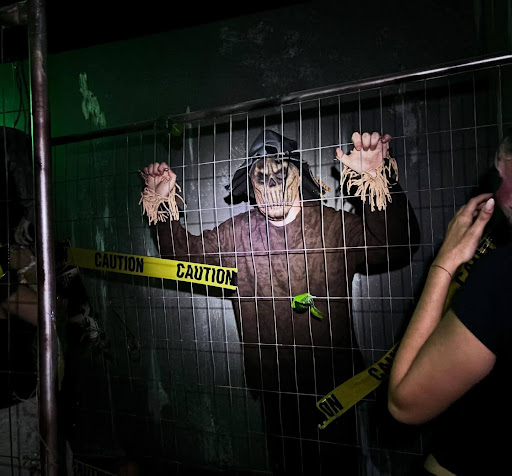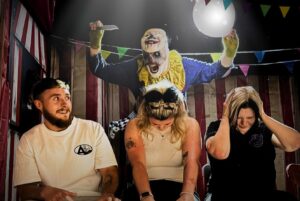There’s something strangely irresistible about fear.
For generations, people have lined up to be scared – from ghost stories around campfires to midnight horror films in packed cinemas. Today, that fascination with fear has evolved into something even more immersive: the rise of horror escape rooms.
Across the world, thrill-seekers are trading popcorn for pulse-pounding reality, stepping into locked rooms filled with eerie soundscapes, cryptic clues, and spine-chilling surprises. The combination of psychological tension, cinematic storytelling, and interactive play has made haunted escape rooms one of the fastest-growing entertainment trends of the decade.
A Brief History of Our Love Affair with Fear
Horror has always held a strange cultural appeal. From the early days of silent films like Nosferatu (1922) and Frankenstein (1931), audiences have been captivated by the thrill of the unknown. These early masterpieces introduced a simple truth that still defines the genre today: fear can be exhilarating when experienced in safety.
By the 1970s and 80s, movies such as The Exorcist, Halloween, and Nightmare on Elm Street made horror mainstream, blending shock with suspense and pushing the boundaries of what audiences could handle. In the 2000s, the genre reinvented itself again with immersive storytelling, The Ring, Saw, and Paranormal Activity blurred the line between reality and fiction.
That same hunger for controlled fear paved the way for immersive experiences, where people didn’t just watch horror, they lived it.
When Horror Stepped Off the Screen
Haunted houses and scare mazes have been around for decades, especially in the US and Japan. But around the early 2010s, the escape room craze merged with the horror genre, creating something entirely new.
In Los Angeles, The Basement became one of the first horror-themed escape experiences, combining realistic sets with live actors who interacted with players. In Tokyo, The Real Escape Game: Escape from the Werewolf Village gave Japan’s puzzle-loving culture a darker twist. These early innovators proved that fear could enhance immersion — and that people would pay to test their limits.
Since then, the concept has exploded globally. From New York’s Escape the Serial Killer to Seoul’s The Horror House Experience, horror-based escape adventures have become destinations for both gamers and horror film fans alike. The mix of narrative storytelling, movie-quality production, and physical participation has made these attractions a genre of their own.
The Psychology Behind the Scare
Why do people enjoy being frightened?
Psychologists say it’s all about adrenaline and emotional release. When we face fear in a controlled environment, our brains respond as though we’re in danger, releasing adrenaline and endorphins. The result is a natural high… a thrilling cocktail of fear and excitement.
Unlike watching a horror movie, escape rooms put participants in the story. You’re solving the mystery while the “monster” is breathing down your neck. That active involvement heightens the sense of danger and makes victory even more satisfying.
For groups, this creates powerful shared memories. When you conquer fear together, you bond — whether that means escaping a haunted mansion, surviving a cursed asylum, or defeating The Nightmare Escape Room before the clock hits zero.
How Horror Evolved Inside Escape Rooms
At first, escape rooms focused purely on logic puzzles and mystery themes. But as audiences grew, designers realised that atmosphere mattered as much as problem-solving. Horror provided the perfect creative playground: flickering lights, sound design, eerie props, and storytelling that built tension over time.
Modern horror escape rooms now rival movie sets in quality. Many feature live actors who chase or taunt players, cinematic lighting, and nonlinear narratives that change based on choices made inside the room. This blend of theatre, gaming, and filmcraft delivers something screen entertainment never could – total immersion.
Some venues even employ professional horror writers and filmmakers to design their rooms. The result feels like stepping inside a living horror movie. except the ending depends on how you play.
A Global Phenomenon That Keeps Growing
Horror escape rooms are not just a passing trend; they’re becoming cultural fixtures. Halloween seasons in major cities now feature special escape events, and streaming-era fandoms for franchises like Stranger Things and The Conjuring have inspired branded horror experiences.
Japan continues to lead in narrative complexity, often weaving folklore and psychological tension into multi-room stories. Meanwhile, in the United States, cities like Los Angeles and Chicago have turned horror escape rooms into full-scale productions that rival stage plays.
And on the Gold Coast and beyond, the appetite for high-intensity, story-driven adventures shows no sign of slowing down.
Why Horror Works So Well
Horror taps into our most primal emotions: fear, curiosity, and the need to survive. But at its core, it’s also about connection. When people experience fear together, they communicate instinctively, support each other, and celebrate every success.
That’s why horror escape rooms are so memorable. They push players out of their comfort zones while giving them the thrill of conquering something truly frightening. It’s more than entertainment — it’s an adrenaline-charged social experience.
Final Thoughts
The rise of haunted escape rooms shows just how far interactive entertainment has come. From early horror films to modern escape experiences, our desire to feel fear — safely and collectively — has only grown stronger.
Whether it’s the sinister puzzles of The Nightmare Escape Room or the creeping tension of a haunted mansion mystery, horror escape rooms turn fear into fun, challenge into teamwork, and storytelling into something you can actually live through.
Because sometimes, the best way to face your fears… is to lock yourself in with them.





